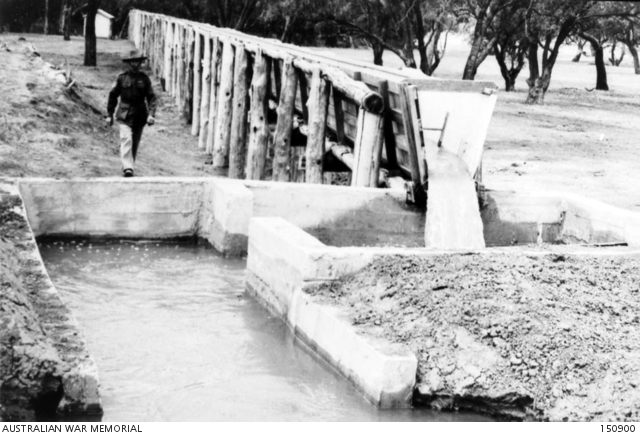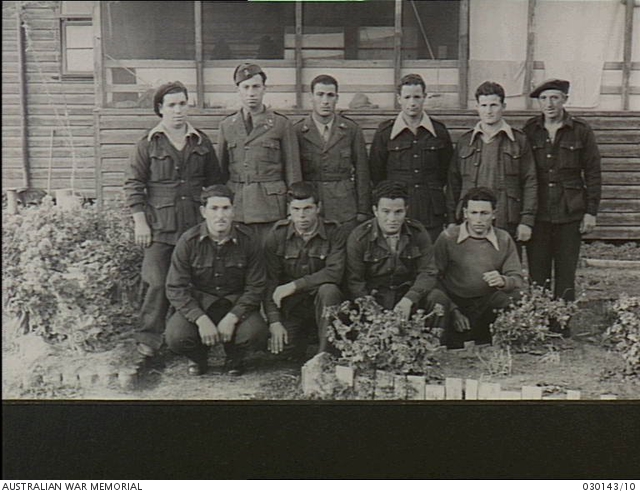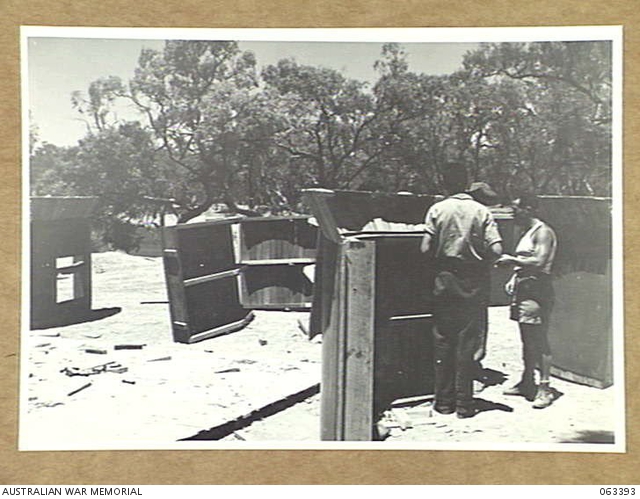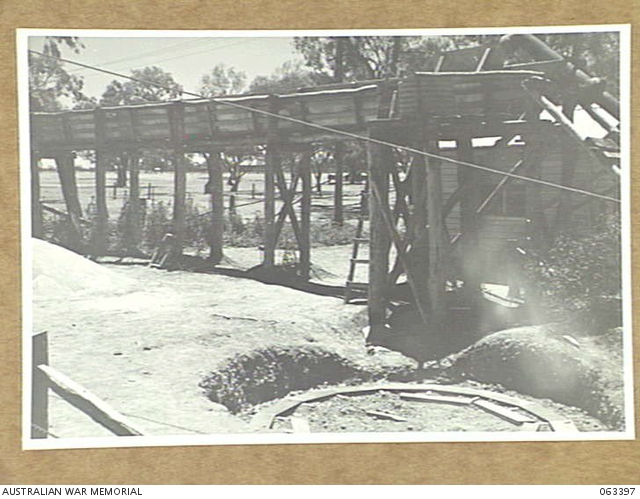Giovanni Marzullo arrived in Australia on the Queen Mary 27th May 1941 and was repatriated on the Otranto 10th January 1947. He arrived into Sydney and departed from Sydney and in those five and a half years his travel in Australia was limited to Hay and Cowra Prisoner of War Camps.
Giovanni was in the group of the first 2006 prisoners of war to Hay Camp 28th May 1941. He was part of a small group of 200 who remained at Hay Hostel – a sub-camp/hostel and agricultural project- until 27th December 1946. Hay Camps 7 and 8 had been vacated on 28th October 1946.




So a little history about Hay Camp, Giovanni’s Australian home …
In a July 1941 report, two months after the arrival of the Italian prisoners of war at Hay, there were no Australian army interpreters on site. “There are no interpreters in this Camp and not one of the P.O.W.s can speak English… The need for interpreters was obvious from every angle of administration, discipline, medical, dental, control of working parties, etc. This lack of interpreters places a great strain on the effective administration and is one that calls for immediate adjustment.” In quick response to this report,two sergeant interpreters had been dispatched to Hay, but “the appointees are not Italians”.
There were other shortcomings:
PAYS
“No pay is being made available to P.O.Ws though the bulk of them are actively engaged on road work, ditching and agriculture as well as camp administration work in connection with the running of the camp. In the absence of any pay for men the personnel have been unable to purchase tobacco, which at the moment seems to be the main hardship, and the supply of which would, no doubt, bevery helpful in the maintenance of discipline. Following a recent visit by the Apostolic Delegate, a cheque for £200 was received from him for the purchase of tobacco for the P.O.Ws. We also learnt that £66 had been donated by the late Civilian internees for the same purpose. Tobacco has now been ordered.”
READING MATTER
“There was no reading matter for the P.O.W., but the Apostolic Delegate is arranging to supply several cases of books for their use. As books are not allowed to pass between the Compounds, the C.O. arranged with the donor to supply duplicates for each Compound.”
RECREATION HUTS
“ A large recreation hut is established and is controlled by the S.Army [Salvation Army]. This had a small stage, various games, and a three-quarter Billiard table was presented during our visit by the Local Welfare Committee. The C.O. realised the unsuitability of the hut (owing to height) for cinema which is desirable for the entertainment of the Garrison, and is making arrangements for increasing the height.”
Michael Lewicki, photographer, captured Giovanni on camera 9th September 1943. He is standing first on the right. The scheme to place Italians on farms had begun in June 1943. By September 1943, farmers in Queensland, New South Wales and Victoria were being recruited to sign up to employ Italian workers. It was at this time that group photos of Italians were taken, like the one below.

Hay, NSW. 9 September 1943. Group of Italian prisoners of war (POW) interned at No. 6 POW Group. In this group are known to be: 46181 Giuseppe Musto; 45685 Bartolomeo Fiorentino; 46799 Angelo Scoppettuolo; 46188 Giovanni Marzullo; 47941 Donato Cendonze; 45519 Giuseppe Dello Buono; 45174 Andrea Cavalieri; 45290 Carmine Cogliano; 45363 Pasquale Cappello and 47996 Mario Cioccolini. Note: The number is an assigned POW number. (AWM Image 030143/10 Photographer Michael Lewicki)
In November 1943 the Red Cross Delegate visited Hay Camps. There were 485 Italians in Camp 7 and 483 Italians in Camp 8. At that stage, “the camps did not have any organised schools which is mainly due to numerous arrivals and departures. However, many prisoners of war are studying privately or in small groups. For the purchase of the necessary books, they generally address themselves to the Red Cross Delegate. These purchases are made at the expense of the interested parties.”
On the 24th December 1943, Giovanni wrote on the inside of his Collins Italian-English Dictionary his details. The stamp on the inside cover of the dictionary is interesting: ‘Approved for Transmission’ . All books had to approved and in the light of the above information, Giovanni paid for his dictionary. Without organised schools, the learning of English was left up to the individual.

Giovanni Marzullo’s Italian-English Dictionary (photo courtesy of Daniele Marzullo)
Building and construction of facilities for Hay POW Camp was an ongoing process. Perhaps Giovanni’s skills as a carpenter were required and the reason for him spending almost all his time in Australia at Hay Camp.
In 1942, there is mention of ‘skilled Italian prisoner of war tradesmen’ building poultry runs, a piggery and a dairy. In 1944, tradesmen were needed to construct farm buildings at Hay Camp. Giovanni was transferred to the Hay Hostel: an agricultural project near the town of Hay on 30th August 1944. He remained at the Hay Hostel until 27th December 1946.

HAY, NSW. 1944-01-17. FARM BUILDINGS IN THE COURSE OF CONSTRUCTION AT THE FARM OF THE 16TH GARRISON BATTALION PRISONER OF WAR DETENTION CAMP. (AWM Image 063390 Photographer Geoffrey McInnes)
On the 9th January 1947, Giovanni boarded the Otranto in Sydney for Naples. His record card is stamped 10th January 1947: Repatriated. The event was reported in the newspaper:
“SOME ITALIAN P.sO. W. SORRY TO LEAVE
The 448 Italians who sailed in the Otranto yesterday were the last to leave New South Wales, apart from escapees who are still at large. They will be disembarked at Naples.
The prisoners appeared well fed and healthy. All of them carried suit cases with blankets strapped neatly to the sides, with bulging kit bags and other luggage. Many had musical instruments. Some of the prisoners said they were sorry to leave Australia and hope some day to return. The ship will pick up 3,000 more prisoners at Melbourne…
The run to Naples will take 27 days, then the Otranto after the troops have disembarked, will proceed to London…” (1947 ‘GUARD WITH ITALIANS ON OTRANTO’, The Manning River Times and Advocate for the Northern Coast Districts of New South Wales (Taree, NSW : 1898 – 1954), 18 January, p. 2. , viewed 15 Mar 2021, http://nla.gov.au/nla.news-article172278675)
Arthur Delves was a passenger on the Otranto and wrote to his parents about his voyage:
“ Very rough one day crossing the Australian Bight. The last point of vantage is Cape Lewis [Leeuwin] and that is closely watched as Aussie. fades from view. Ten days brought us to Columbia [Colombo] but did not stay, only delivered and received the mail. The day’s travel is put out on the notice board every morning, “Speed seventeen, sometimes eighteen knots an hour, distance travelled, time and date for the previous day, 380, sometimes 400 miles. Suez Canal is near and we go through at night, so will miss seeing one of the outstanding sights… the Pyramids. On one side of the sea is the River Nile and on the other the Jordan… I am a good sailor and finished one of my letters through the rough part of the trip in the Mediterranean. We were to have landed at Athens in the morning, but on arrival the signals were up that it was too rough to come into the pier. We landed our big army of soldiers [Italian prisoners of war] all right and the gangway was clear by 9 am…” (1947 ‘A TRIP TO THE OLD COUNTRY’, The Northern Champion (Taree, NSW : 1913 – 1954), 31 May, p. 6. , viewed 15 Mar 2021, http://nla.gov.au/nla.news-article162166470)
Giovanni had arrived in Italy. His short journey home from Naples to San Giorgio Del Sannio (Benevento) must have felt like one of his longest journeys.





The Australian War Memorial has a comprehensive collection of photos of Hay Prisoner of War Camp. I acknowledge photos in this article as being from the AWM Collection.

Bene, io cerco l’eventuale permanenza quale POW in Australia di mio zio Renato MARINI, fatto prigioniero a Tobruk, Libia, o in Ethiopia, e tornato a Roma molti anni dopo. Grazie.
LikeLike
Ciao Bruna, I cannot find a Renato MARINI. Can you send me his date of birth. My email is joannetappy@gmail.com Joanne Tapiolas
LikeLike